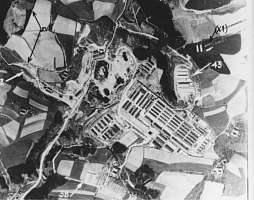KZ Mauthausen Central Camp
Establishment

Several weeks after the annexation of Austria to the Third Reich, decision was made in 1938 to establish a set of two concentration camps in the St. Georgen-Gusen-Mauthausen area.
Although the SS bought the first plots of land for this bifurcated concept at first at Gusen, a first makeshift concentration camp was established down in the Wienergraben Valley at the border between the communities of Langenstein and Mauthausen on land leased from the City of Vienna in autumn 1938.
Along with this it is important to note that already in 1938 concentration camp inmates of this Wienergraben makeshift camp were also marched daily via the village of Langenstein to granite quarries of Gusen - a location that was in the focus of the SS from the early beginning too. It is also fact that some of the first officially registered victims of Camp "Mauthausen" were actually murdered in the granite quarries of Gusen already in early 1939.
It was also only during 1939, that the SS managed to construct first prisoner barracks on the hill, where Camp Mauthausen is located today.
While Camp Mauthausen was built in a serveral year long period like a medieval fortress with heavy granite stone since 1939, the twin camp at Gusen became fully operational much faster in 1940 as "the slaughter house" of the KZ Mauthausen-Gusen complex because of its wooden makeshift design.
With the exemption of one year, Camp Gusen housed more inmates than its twin camp above the Wienergraben Valley that was called “Mauthausen” by the SS after the nearby town, although the camp was actually errected on the territory the rural community of Marbach.
While the SS located the regional command for the two concentration camps at Mauthausen (Amt D), it located the regional leadership of the corresponding SS enterprises at St. Georgen/Gusen (Amt W).
This clearly shows that the SS focused its economic interests to the Gusen part of this twin complex very early.
This is also expressed by the acutal size of the Gusen part and the fact that the number of inmates and also the number of victims of the Gusen part surpassed the corresponding numbers of Camp Mauthausen significantly.
The Gusen twin camp was also widely independend of Camp Mauthausen and had also its totally different inmate numbering system for years. Both systems were only merged in early 1944 into one common system.
For further details about the camp at Mauthausen, please follow the website of the Mauthausen State Memorial.
#RememberGusen